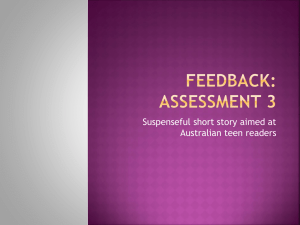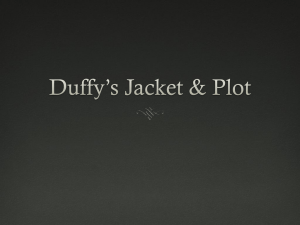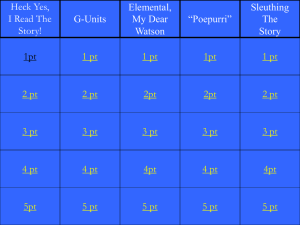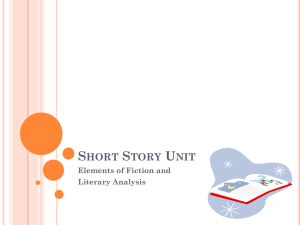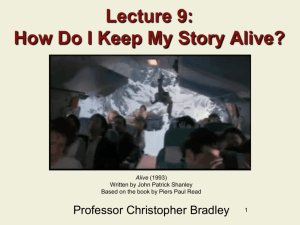The Narrative Structure
advertisement
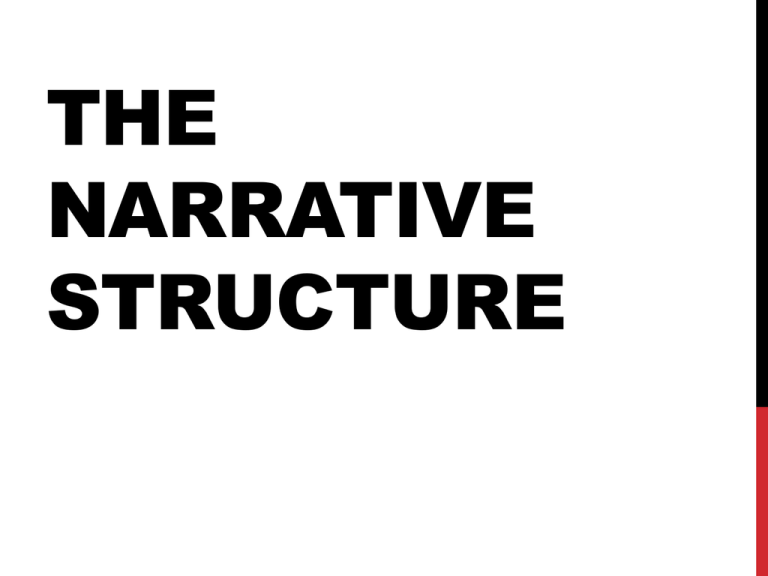
THE NARRATIVE STRUCTURE THE NARRATOR in every movie, the camera is the primary narrator First-person narrator voice-over narration (example) direct-address narration (example) Third-person narrator • someone removed from the story provides info not accessible by characters in the movie omniscient (unrestricted access to all aspects of the story) (example 1) restricted (limits the info given, usually from only one character CHARACTERS Almost all film narratives depend on two essential elements: a character pursuing a goal Each new character makes it possible to have a new take on the same old story • round characters – complex characters, change over course of film • flat characters – uncomplicated, few distinct traits, no change (article, video) CHARACTERS… Whatever type of character, narrative cannot exist if the character does not have a goal • gives the character something to do • gives the audience a chance to participate/get involved in the story by creating expectations CHARACTERS… Protagonist – the primary character who pursues the goal • sometimes referred to as a hero (not necessarily w/worthy goals) (sample lists 1 2 3) • as long as the protagonist actively pursues the goal in an interesting way, viewer will be invested in the pursuit • anti-heroes: unsympathetic protagonists chasing less than noble goals Narratives thrive on imperfect characters = imperfections provide obstacles • aka: character flaws • character imperfections/flaws give characters more room to grow THE BASIC NARRATIVE STRUCTURE: → a clearly motivated protagonist → pursues a goal → encounters obstacles → a clear resolution NARRATIVE STRUCTURE: THE ORGANIZATION IN THREE ACTS Most narratives can be broken into three basic parts: first act sets up the story, second (and longest) act develops the story, and third act resolves it ORGANIZING THE STORY For a 120 minute film: FIRST ACT Tells what kind of story it is by establishing the “normal world” • lays out rules of the universe we are about to experience • a hook (think Indiana Jones) • characters are established with something about the protagonist’s current situation Inciting Incident – something will occur to change the normal world and set protagonist on pursuit/mission/quest… • presents the character with the goal to drive the narrative • most are easy to spot (w/in first 10-15 min) example (youtube) • some goals shift (Star Wars: fist to rescue princess, then the take on Death Star) SECOND ACT Second act is the story, or the pursuit of the goal (ie: Will Dorothy ever get back to Kansas?) • the impulse to learn what and how keeps the viewer engaged • want the answer to be yes – but ironically, if goal was quick/easily attained, the story is over: need conflict • the story depends on obstacles • Antagonist; nature of is varied, not always a villain, sometimes not human (the rock in 127 Hours) • the stakes need to rise – deeper we get in the story, the greater the risk to the protagonist • building toward a peak (rising action) building toward a turning point • at the peak, the goal is in its greatest jeopardy THIRD ACT Climax and solution, loose ends tied • the climax comes when the protagonist faces this major obstacle – it’s the most impressive event in movie • best stories have an unexpected solution • some continue to struggle in the third act but eventually the story resolves • resolution/dénouement STRUCTURE ANALYSIS The King's Speech The Matrix Thelma & Louise E.T.: The Extra-Terrestrial IT’S NOT THAT EASY… What’s wrong with the three act structure But a good, brief explanation THE SCREENWRITER Builds narrative structure and creates every character, action, line of dialogue and the setting • done with fewest lines possible Each page of script represents one minute of screen time Must create compelling stories, engaging plots, and fascinating characters, AND must understand what is marketable ELEMENTS OF NARRATIVE Story v. Plot • stories may be common (Cinderella) but plots can change (Pretty Women) Order • bringing order to the events is one of the most fundamental decisions filmmakers make • with so little time, must decide what to include/not include • plot can be manipulated so events are presented in nonchronological order (eg: Citizen Kane, Memento) • despite this, most narrative films follow traditional chronological order Events • we infer the event’s relative significance through the director’s selection and arrangement of details of action, character, or setting Duration (Citizen Kane, story duration: 70+ years, plot duration: ~ 1 week, screen duration: 1hr, 59 min. • story duration: amount of time the implied story takes to occur • plot duration: elapsed time of the events within that story (the time of the plot) • screen duration: movie’s running time • balancing the three is complex, presenting stories in a relatively short amount of time Surprise v. Suspense • surprise: being taken unawares, can be shocking and our emotional response to it is generally short-lived • there are no repeat surprises; can be surprised the same way only once • suspense: more drawn-out experience, involves the audience SUSPENSE V SURPRISE In a now-legendary 12-hour interview with Francois Truffaut, Alfred Hitchcock explained the pivotal difference between surprising your audience and keeping them in suspense. "We are now having a very innocent chat," said Hitchcock. "Let us suppose that there is a bomb underneath the table between us. Nothing happens, and then all of a sudden, 'Boom!' There is an explosion. The public is surprised, but prior to this surprise, it has seen an absolutely ordinary scene of no special consequence." "Now, let us take a suspense situation," Hitchcock continued. "The bomb is underneath the table and the public knows it, probably because they have seen the anarchist place it there. The public is aware that the bomb is going to explode at one o'clock and there is a clock in the decor. The public can see that it is a quarter to one. In these conditions this innocuous conversation becomes fascinating because the public is participating in the scene. The audience is longing to warn the characters on the screen: 'You shouldn't be talking about such trivial matters. There's a bomb beneath you and it's about to explode!'" "In the first case we have given the public 15 seconds of of surprise at the moment of the explosion. In the second we have provided them with 15 minutes of suspense. The conclusion is that whenever possible the audience must be informed." Repetition • the number of times a story element recurs in a plot • appearance more than once suggests a pattern = a higher level of importance Setting (time and place in which the movie takes place) • provides essential contextual info that helps the viewer understand story events and character motivation • adds texture to the movie’s diegesis • the world of the film’s story
